Glasgow Cathedral
The dark and rather mysterious looking Gothic Glasgow Cathedral is built on the site where the first Bishop (St Mungo) of the old British Kingdom Strathclyde lived and died…. For the record, this is the only cathedral in medieval Scotland to have survived the 1560 reform without being unroofed. Prayers have been offered regularly to the almighty for the last 800 years and right now the church’s recitals and choir services are broadcast live and are recognised to be one of the finest in Scotland.
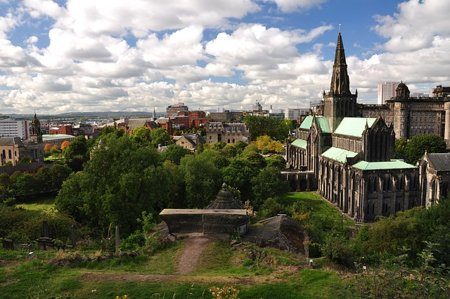
Look out for the finest post-war collections of stained glass windows inside. The Blackadder Aisle with its stunning Monochrome ceiling and colourful Bosses is another noteworthy attraction inside. The church actually has 2 levels and the lower church contains the biggest treasure of Glasgow… a beautiful crypt containing the remains of Glasgow’s patron Saint Mungo. There are enough historical artefacts and spiritual exhibits around the crypt to keep you occupied for hours…you can learn about surprising facts like the origin of Glasgow’s name and the mystery behind St Mungo’s lineage.
Other amazing attractions inside are the Pulpitum with its carvings depicting the 7 deadly sins. The Grand Organ of the church has its own fascinating lore and so do all of the numerous chapels in here. It’s fascinating that this free to visit church also offers free history and culture-oriented guided tours by the church volunteers. Well connected by subway and bus the Glasgow Cathedral stands on the eastern side of the heart of the city and is very easy to reach.
Read: Glasgow Cathedral for detailed information.
Kelvingrove Park
Created in 1852 as Glasgow’s addition to its west end and a middle class-oriented green respite from the urban grog that had been troubling the city… the Kelvingrove Park soon became the soul of the city. Sprawling across 34 acres, the park offers ample amenities and abundant greenery other than a nice assortment of birds and local fauna.
Each visitor to the park feels at home amongst the cheerful groups of parents walking prams and couples walking dogs. Bird watchers, kids, runners, joggers, students and artists all feel at home in the Kelvingrove Park. Best events in Glasgow city like the Glasgow Mela and Glasgow Pride Walk have chosen the Kelvingrove Park has their venue.
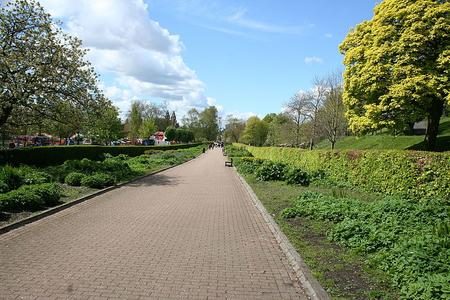
The 22 galleried Victorian-style Kelvingrove gallery and museum is a huge attraction and so is the bandstand that now holds some of the best live shows and music concerts of Glasgow. The bowling greens had hosted the 2014 edition of commonwealth games and the tennis courts have superb amenities besides being free to use.
Look out for the meandering walks, old bridges and beautiful statuary including the rather extravagant Lord Provost Memorial fountain. There is a cute little café in the park and beautiful seating spaces and floral hedges that are neatly dotted with bins. Little surprises dot the park like a skating area, a lake with a mysterious island, an Italian garden and some thought-provoking art.
Read: Kelvingrove Park for detailed information.
Kelvingrove Art Gallery And Museum
The Kelvingrove Art Gallery and Museum is undoubtedly one of Glasgow’s reigning attractions and commands an impressive number of visitors each day. 22 amazingly coordinated galleries sit inside and they encompass a wide range of themes from Egyptian art to Dutch Old Masters and French Impressionists to the famed Christ by Salvador Dali. Charles Rennie Mackintosh’s eclectic design creations that span interior and furniture design, prints and photographs occupy one entire wing.
The museum is also the best place in Scotland to know about the work of the Glasgow Boys and the Scottish Colourists who were probably Europe’s most significant new-age painters. One of the richest arms and armour collection sits inside the museum and an actual Spitfire plane that flew in the Second World War is suspended from the ceiling.
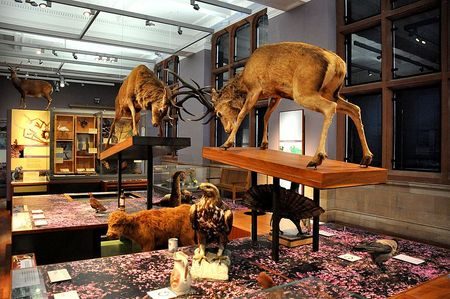
Kids will love the adventurous natural history section with its Dinosaurs skeletons, stuffed animals and the museum’s oldest resident Roger the elephant. Astronomy and science lovers will be bewitched by the Fulton’s Orrey … a beautiful solar model demonstrating actual positions of the planets as they were believed to be in those times. Then there is an exquisite stained-glass collection that depicts the Coronation of the Virgin and an entire series of work on European jewellery design by the famous Annie Grundy.
The eclectic nature of the displays and the rather ornate ambience of the Gallery creates an ‘Alice in Wonderland’ effect!! A café, restaurant, halls (one with a gorgeous pipe organ) and a study centre library are just some of the other amenities in this interesting museum and gallery. It’s amazing to think that there is free entry to this place.
Read: Kelvingrove Art Gallery and Museum to know more.
Riverside Museum
Built on the Pointhouse Quay on the northern banks of the River Clyde, the Riverside Transport Museum is one of the top attractions of Scotland. Many find it difficult to tear themselves away from continuously photographing the brilliantly designed building by Zaha Hadid. The Riverside Museum seems to join the city and the Clyde River in a series of sharply peaked waves with a gleaming frontage that reflects the river and the Tall Ship that’s moored beside it.
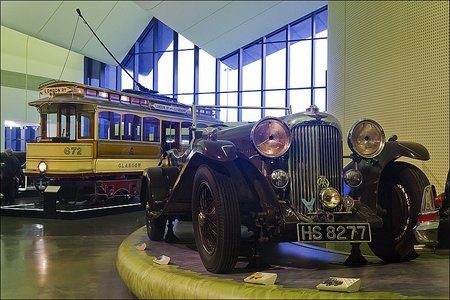
Once you get in, a walk inside is a thorough lesson in the transport history of Scotland and an exposure to the excellent heritage of Glasgow when it comes to this industry. There is a section devoted to maverick racer Graeme Obree and a toy display window featuring a stormtrooper cast from an actual Star War costume set. There are recreated streets featuring pre-World War II, Glasgow, with vintage cafés and antique photography shops and there is even a reconstructed cinema counter showing short films on transport.
Expect to see an entire wall of cars, a suspended roof display of bicycles, a collection of Pakistani truck art, prams from different eras, and carriages with life-size stuffed horses and locomotives including a giant South African model. There are lots of interactive displays inside each section and you can actually climb inside many of the vehicles to get an intimate feel. For many visitors, the chief attraction is the ‘Tall Ship’ which is moored alongside the museum.
The SS Glenlee is an actual functioning ship filled with activities and exhibits that will delight all souls who come to visit it. Besides the main exhibition space, there are 2 cafés, events plaza and a lovely open terrace… the museum is an ideal family outing venue.
Read: Riverside Museum for complete details.
National Piping Centre
The ethereal looking cream coloured Church on Mac Phater Street doesn’t give much indication of the treasures that are housed inside its walls. Look up to its magnificent and subtly lyrical stained-glass windows and know that they are representatives of major strains of Bagpipe music… a unique amalgamation of melody and art in jewel blue tones. The Piping Museum inside is compact but holds in its grasp 300-year-old history of the music of Bagpipes.
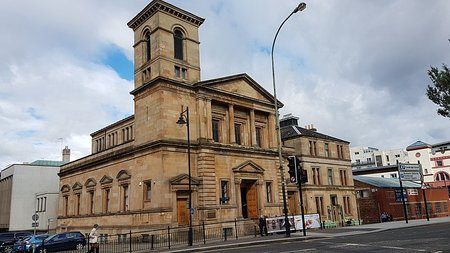
Browse through amazing artefacts like the Robert Burns Bagpipe, Mac Kay Chanter, ancient bagpipes etc. The refurbished museum offers a nice selection of tours that encourage guests to try their hand at playing the instruments and listening to live music sessions besides a thorough audio-guided tour of the museum and its collections.
Walk into the adjoining space that holds the Pipers Tryst restaurant …an authentic Scottish dining experience that offers most traditional Scottish delicacies and desserts along with old-world hospitality standards. Or you could decide to stay at the Pipers Tryst boutique hotel that’s done up in traditional Scottish décor and is a good base for enjoying your stay at Glasgow… especially if you come at a time when the Piping Live Celebrations are on!!
The National Piping Centre (NPC) has its own learning centre that now offers an assortment of courses in bagpipe music to domestic and foreign scholars including e-learning courses too. There is a shop selling CDs, highland wear, printed music sheets, souvenirs and bagpipes of every type. Just 10 minutes away from Glasgow City Centre, the National Piping Centre is a beautiful all-round destination for all lovers of music and culture.
Read: National Piping Centre for complete details.
Hunterian Museum and Art Gallery
Walk into the magical Hogwarts style main building of the Glasgow University (also known as the Gilbert Scott) and you will be exposed to the Hunterian Collection. A completely free to browse, a comprehensive collection of artefacts, science exhibits and art… the Hunterian collections are known to be one of Scotland’s biggest cultural assets.
The permanent exhibition is dedicated to the life of the well-known Scottish obstetrician, collector and teacher Dr William Hunter. Incidentally, Dr Hunter was the founder of Hunterian Museum and he had a prosperous career as a Royal physician as well as a superlative teacher of anatomy and surgery.
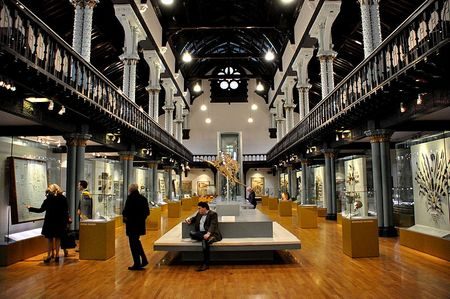
Dr William Hunter had amassed thousands of objects that demonstrate his artistic, medical and intellectual prowess. There are sketches on paper, wood, shells and a vast collection of fossils, zoological specimens and anatomical constructs. You will see collections of preserved insects, rare Eastern manuscripts, books and unpublished material collated by Dr Hunter as well as other luminaries of his time. The Hunterian exhibition also contains one of the best working libraries of 18th century London. The Hunterian Collection also includes medical instruments used by Dr Lister, scientific apparatus used by Lord Kelvin and James Watt… all displayed in a wonderful setting.
Then there is the Hunterian Art Gallery containing a remarkable collection of art by Rembrandt, Scottish Colourists, Charles Mackintosh and James Whistler. The Mackintosh House with its painstakingly recreated interiors and startling décor scheme is another major attraction.
The Hunterian collections are not to be rushed through as some of the pieces provoke onlookers to mull over the cycle of life and death while others provoke intense admiration about the achievements of mankind in both art and science. Families with slightly older kids will benefit a lot from visiting the collection as it’s nothing short of a detailed foray into the history of civilisation.
Read: Hunterian Museum & Art Gallery for complete details.
Glasgow University
One of the most prestigious universities of the world, the Glasgow University is known for producing luminaries like William Thompson (Lord Kelvin), Joseph Lister, James Watt, William Hunter apart from an array of politicians, Nobel laureates and artists. The Glasgow University is now hosted at multiple locations but the Gilmorehill campus is the most well-known and architecturally a brilliant location. The Gilmorehill campus is home to the famed Hunterian Museum and the Art Gallery along with the Mackintosh House…all of which are called the best cultural assets of Scotland.
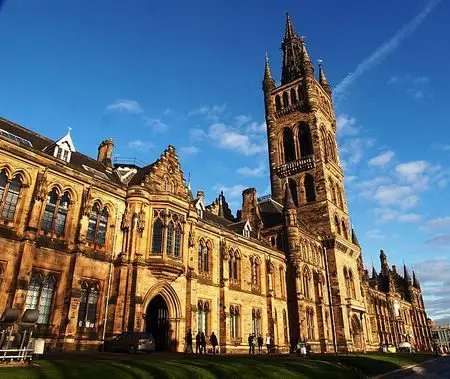
What’s more, visiting all parts of the Glasgow University Campus is free if you do a self-guided tour apart from entry to any special exhibitions that may be happening here. The Library is known to be one of the finest in UK and the main building with its eye-catching spire and arches (known as the Gilbert Scott) has been known to inspire Hogwarts. There are so many places to visit on campus …right from the terraced townhouses on the Professors Square to the Lion and Unicorn Staircase to the fabled Cloisters (the seat of the Graduation ceremony).
Visit Lord Kelvin’s House and get a bird’s eye view of the city from the University Flagpole. Learn about the fascinating University lore like why it’s considered bad luck for undergraduates to walk across the lawns in the beautiful east and west quadrangles. Shop for tartans and university merchandise at the gift shop and attend the service at the University Chapel. With many restaurants and cafes and luscious lawns bordered with blooms and shaded trees…the Glasgow University is indeed a perfect intellectual and historical destination. Only an half an hour walk from Glasgow City Centre, the University of Glasgow is convenient to reach and explore!!
Read: Glasgow University Attractions to know what to see & do when you visit the university.
Glasgow Botanic Gardens
One of the best-loved green spaces of Glasgow, the Glasgow Botanic Gardens started off as a sidekick to the Glasgow University but soon became a major attraction in its own right. William Jackson Hooker… erstwhile professor of Botany at the Glasgow University was one of the ruling reasons behind the exponential growth of the garden’s collection… this passionate lover of plants travelled all over Scottish Highlands along with David Douglas to gift the gardens with an enviable collection of herbs, plants and shrubs.
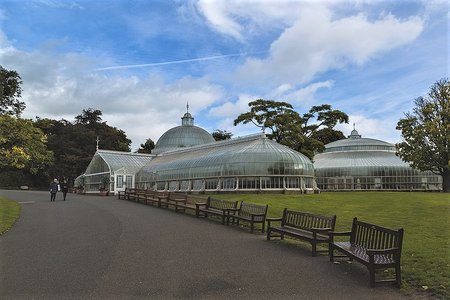
The fern collection became so extensive that Scotland recognises it as ‘the National Collection of Ferns’. The ever-growing collections demanded greenhouses and several glasshouses were assembled inside the garden… the most spectacular of which is the Kibble Palace. The spectacular curvilinear palace was once the private property of John Kibble (eccentric artist, brilliant trader and gifted photographer) in Coulport but it joined the Glasgow Botanical Gardens property in 1873.
A marvellous collection of statues rest inside besides a fountain and ponds full of water lilies. You will be able to see a collection of carnivorous plants, cacti, shrubs and the National Collection of ferns inside the Kibble Palace. Besides this, the Glasgow Botanical Gardens contain a World Rose garden, medicinal herb garden, vegetable garden and children’s miniature garden with a red little house and matching chairs. Spend your time inside feeding the birds while sitting on benches or taking the lovely heritage walk that winds around the park before moving on to the Kelvin way and the enchanting banks of the Kelvin River. Incidentally, the Kelvingrove Park and Museum is nearby and many tourists prefer to explore both thee gorgeous green spaces in one day.
Read: Glasgow Botanic Gardens for complete details.
Glasgow Green
Glasgow Green is easily the best-loved green space of Glasgow. This was Glasgow’s only green space at one point of time and besides providing a breather to the commoners (East-Enders) part of the space was also used as a place for washing, drying and cleaning. The lovely red Templeton Carpet Factory building that hosts the WEST brewery is a leading attraction and so is the ornamental 3 tiered Doulton Fountain that stands in front of the People’s Palace.
There is a lot to do inside the Glasgow Greens… pathways in which you can take walks and multiple children’s play areas with hammocks, swings and climbing sets. There are memorials, plaques, statues and fountains all depicting different victories, contributions and events in time. Some like the Nelson Column are ‘A’ listed monuments while others like the Time Spiral has captured all momentous events in an interesting circular formation that allows visitors to walk through time.
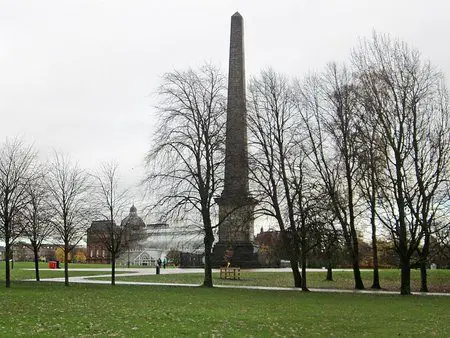
The People’s Palace will justifiably take up a lot of your time and there are great displays inside that show the history and culture of Glasgow (especially its East End) as it changed over the years. There is the Barrowland Ballroom, Single End, Steamie and the Doon the Watter all of which tell the story of Glasgow. There are amusing exhibits like the Billy Connolly Banana Boots that showcase the humorous spirit of Glasgow. People’s Palace justifies its description as the social history museum of Glasgow.
Glasgow has many rich collections of art, staggeringly beautiful statues and lovely monuments that depict the tastes of the rich, elite and the mighty. However, the Glasgow Green represents the vast majority of the Glaswegian commoners whose lives were full of strife, struggle and joy in a relatable mixture that most people will easily relate with.
Read: Glasgow Green to know all about it.
Glasgow Science Centre
The brightest jewel in the architecturally brilliant Pacific Quay redevelopment project, Glasgow Science Centre is every photographer’s dream with its elliptical simmering titanium-clad body. The country’s first (and best) IMAX and the Glasgow Tower (winner of Guinness book award) flank the Science Centre and together makeup one of the most visited attractions in Glasgow. A ticket to the Science centre will allow visitors entries to all its exhibitions, workshops and staggering array of interactive exhibits. Tickets for the planetarium shows and IMAX documentaries can be brought as add-ons at reduced prices.
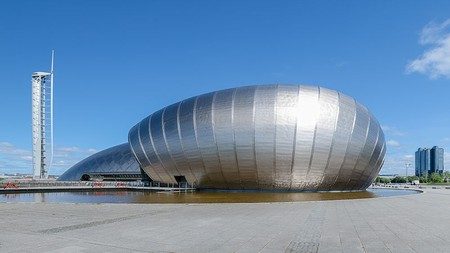
The planetarium is home to a Zeiss optical-mechanical projector that marvellously projects images into a dome of 15m diameter… one of the most spectacular ways to watch a space show. This thrills adults, geeks, wannabe scientists and kids alike though there is a specific area devoted to kids called the Big Explorer. On floor 1 of the Science centre (also referred to as Science Mall), there is a visually stunning science show theatre while floor two has loads of interactive exhibits that teach visitors about power conservation, quantum physics, visual illusions etc. besides being home to interesting workshop venues.
Visitors are usually stunned to visit the BodyWorks section on the third floor… here is the chance of mapping out individual physiological characteristics like cardiovascular capacity, lung capacity, grip test etc. and getting them all encrypted in a special bar code. At the first look, Glasgow Science Centre may look like an attraction that appeals only to geeks… it takes just a few minutes inside to appreciate its Alice in wonderland like character. Most visitors end up falling in love with GSC and end up planning multiple visits.
Read: Glasgow Science Centre for details.
George Square
The People of Glasgow love their beautiful city centre gathering space ‘George Square’. Be it any occasion like Christmas or St. Andrews Day or Hogmanay…there is usually great bonhomie, stalls and plenty of music and food flowing here. It’s hard to imagine that this lively square decorated by statues of Scotland’s good and great was once a wasteland where cattle were grazed and occasionally horses were slaughtered.
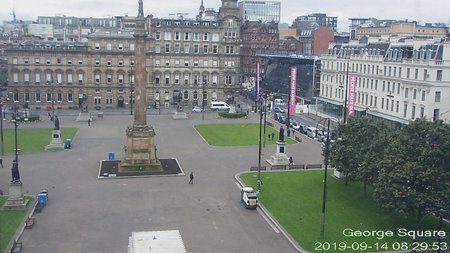
The history of George Square (named after King George III) is the history of Glasgow and its morphing into an industrial, marine engineering giant. It’s also a story of its traders, tobacco lords and protestors and engineers all of whom have crafted a piece of Glasgow’s history. Soldiers for the Great War were recruited here and the most accurate set of measuring sets was laid down here for the world to see.
Look out for the ornate Glasgow City chambers and go in for a free tour. Sip a drink at the Counting House…a bank converted into a restaurant. Admire the Merchant’s House and go off shopping in the boutique and café filled depths of Merchant City. At the heart of Glasgow’s city centre…George Square is ideally the first stop of your Glasgow tour.
Read: What to see & do in George Square
Glengoyne Distillery
Labelled as one of the most beautiful distilleries in the world, the spirits of the Glengoyne have won many awards in national and International whiskey championships like the International wine and spirit competition and San Francisco World Spirits Competition. Operating since 1833, the Glengoyne today creates some of the best south Highland single malts and offers the best whiskey experiences in Scotland. Its heritage, history, friendly staff and devotion to the creation of its heavenly amber spirit creates an interesting cocktail… one that visitors love to sip and savour.
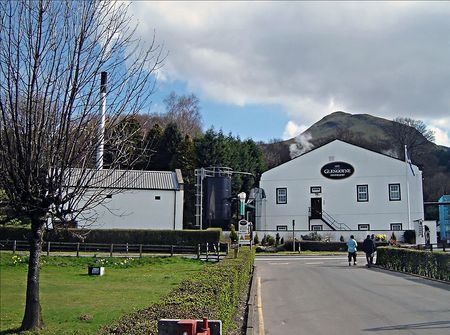
The Glengoyne is known for its high standards of ecological sustainability and adherence to traditional methods of whiskey making… stuff about it has created articles in leading magazines!! The tours here are carefully curated with the 45-minute basic tour offering a comprehensive lesson about the history of the place and the distillery while the Master class tour offers 5-hour immersion in the art of creating your own blend before tasting a wide range of single malts.
There are speciality tours like the Whiskey Chocolate tour that teaches the tongue about the pairings of different chocolates and whiskies and the Number 1 Warehouse tour that takes visitors inside the locked iron gates of the old warehouse. The Glengoyne also offers private dining experiences in collaboration with Chef Justin, a great shop stocking single malts and cute souvenirs and curated events.
The lovely bird-filled woods, abundant wildflowers and the gushing waterfall behind the distillery make for an enchanting magical forest setting for it. A trip to Glengoyne can also double up with a hike up the Dumgoyne and a foray into the Trossachs National Park for some fishing, boating and adventure activities. With Bus number 10 taking you to the doorsteps of the Glengoyne in a little above an hour from Glasgow central, reaching here is not an issue. However, tearing yourself away from the warm fuzzy blends at Glengoyne might just break your heart.
Read: Touring the Glengoyne Distillery for details.
Celtic Park
Nestling in the Parkhead area of Glasgow, the Celtic Park is home ground to the Celtic Football Club and is the biggest football stadium in Scotland. Fans lovingly call it the ‘Paradise’. The merchandise of the Club i.e. T-shirts, accessories etc. are collectable items that are sold from the Club’s stores in its home ground and other locations like the airport. The Club has a very interesting history that covers its story from 1892 to its glorious wins in this millennia. The Club has magnificent statues of its star players, gorgeous multi decker stands and cafes and restaurants including the famed Number 7 that serves 3-course meals.

Take the ever-popular stadium tour that will allow you to view the board room, changing room and trophy room besides giving you the chance to walk through the tunnel into the dugout area. The Celtic Club is one of UK’s most loved clubs and if you happen to catch a match over there, the eclectic ambience and infectious enthusiasm will tell you why. The entire stadium is surrounded by billboards of the club’s favourite players and pictures of glorious match wins and trophies. Visiting the stadium is a lesson in team spirit, history and sports and is a peek into the Scottish sports heritage. Don’t miss a stop at the gift shop inside and pick up some sports memorabilia to remind you of the Celtic.
Read: Celtic Park and Its Tour for complete details.
Glasgow Necropolis
To the east of Glasgow City Centre, lies one of the most artistic cemeteries of the world… the Glasgow Necropolis. Inspired by the Parisian Pere La chaise, the Necropolis is laid down as a luscious garden rather than just a plot based burial ground. The leading freemasons of Victorian Glasgow were the brains behind this cemetery and code breakers and architectural sleuths still obsess over the codes and messages locked away in the Glasgow cemetery arches and memorials.
This is one of the most photogenic destinations you will ever visit… right from the graceful Bridge of sighs leading to it to the ornate arches opening up to the cemetery to the hill on which the John Knox statue stands guard beautifully. Most photographers are fascinated by the huge array of Egyptian mummy style tombs, angle decked memorials and interesting sculpture that dot the cemetery. One of the leading attractions here is the Celtic Cross designed by Charles Rennie Mackintosh… this was arguably his first public work.

There is more to the Necropolis than just the tombs… a wide variety of squirrels, rabbits, birds and butterflies frolic around in the park much to the delight of kids who are invariably found playing inside. Shaded corners under trees tempt book worms while the dates and inscriptions on monuments fascinate historians. There is a section devoted to martyrs in the Korean War while another section poignantly houses tombs of stillborn children with their mothers.
Exploring the Necropolis is a peek into Glasgow of Victorian times… you will find artists, engineers, merchants, writers and commoners (all of different faiths) buried together and their tomb inscriptions will tell you more than any history book? A few minutes away from the high street train station, Glasgow Necropolis is always easy to reach and fascinating to explore.
Read: Glasgow Necropolis to know what to see and do there.
Buchanan Street
Glasgow’s most iconic street Buchanan Street sits at the fusion between the city’s Victorian centre and the Merchant’s zone. The Clyde River lies at the south end of this street and it links two shopping paradises of the city; Argyll Street and Sauchiehall Street. This is a vehicle-free zone and the sides of the street are lined up with impossibly majestic Victorian and Edwardian style buildings that are now home to high street brands, jewellery stores, restaurants, cafes and pubs. Catch displays of street art, performances of street theatre and watch bagpipers play lilting Scottish melodies… there is never a shortage of entertainment on the Buchanan. No wonder that it was voted one of the UK’s favourite streets time and again.
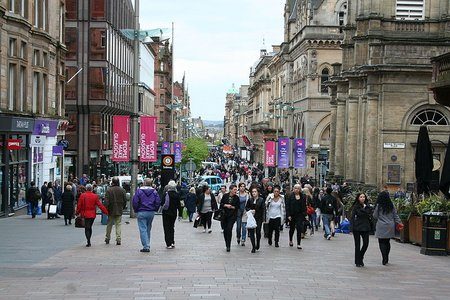
Wander on this street and you will surely be tempted to enter the Buchanan Galleries and the St Enoch Shopping Centre. Photograph the majestic looking Princes Square and go for a beauty haul at the iconic House of Frasers. Don’t forget to admire the Royal Concert Hall and salute the statue of Donald Dewar…he was called the Father of Scotland. Tourists exploring Buchanan Street often branch off into the beautiful George Square or explore the Gallery of Modern Art, Mitchell Library, and Lighthouse etc.
Extremely well connected… Buchanan Street has two metro stations at its two ends (Buchanan Street Subway station and St Enoch Subway station). The old school Queen Street train station lies a little further away while the super busy Buchanan bus station with its quirky kissing couple statue is also nearby. Historically, commercially as well as aesthetically… Buchanan Street is the place to be if you want to experience the best of Glasgow in a mighty short time.
Read: What to see & do in Buchanan Street.
 A travel addict. Still celebrating the day when he quit his high-profile corporate job to pursue his passion for travel writing.
A travel addict. Still celebrating the day when he quit his high-profile corporate job to pursue his passion for travel writing.